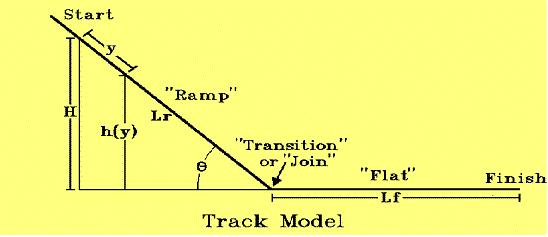
| Grand Prix Racing - | The Science of Fast Pinewood Cars |
Use this datasheet to record your track measurements for use with the simple closed race model. Even though your track may have a more gentle transition than the simple model track, use this model if there is a distinct straight slope from the starting line and a long flat run out at the end. If your track is not shaped closely enough to the model shape, you may be able to use a different race model.
Bear in mind that you will not be able to use the simple closed race model equations if you use a different track model. For the simple closed race model, you will need the following information about your club's track to run a "virtual" race. Each parameter can be measured directly but certain ones may be calculated from the others if the direct approach proves difficult. Use these measurements if your race is on an "Official AWANA" track.
To make the measurements, you will need is a tape measure marked in inches, preferably marked down to 16ths. A protractor may be used, but it is not necessary since the angle to be measured can be calculated if the other measurements are made. A scientific calculator with a radians mode may be needed.
If your track has a more gentle transition than this simple track model, you will need to determine the position of the "join" of the ramp and flat parts. Either on graph paper or in your mind, make a scale drawing of your track. Extend the surface of the ramp from the starting line to the floor at the ramp angle. Extend the surface of the flat from the finish line to the other extended surface. The point where the two extensions cross is your "join". If you find this difficult to do, your track may not be enough like the simple track model. Use the extended ramp and flat to make the measurements below.
| SYMBOL | VALUE | UNITS | How to measure |
|---|---|---|---|
| H (start height) | inches | Measure the vertical height from the starting line to the level of the surface of flat. The surface of the flat is always elevated by at least the thickness of the track. It may be simpler to just measure the distance from the starting line to the floor, then subtract the height of the surface of the flat. | |
| Lr (ramp surface length) | inches | Measure the length of ramp surface from the starting line to the join. | |
| O (ramp angle) | radians | Measure the angle of the ramp surface from horizontal. If you'd
rather calculate the angle, use O = -arcsin(H/Lr). The sign is negative because the cars run down the slope of the ramp. |
|
| Lf (flat surface length) | inches | Measure the length of flat surface from the finish line to the join. |
Mathematically, the simple track model looks like this using the arc parameter, y, to model position on the track surface as it appears to a car:
Grand Prix Track Geometry Model
| EXPRESSION | UNITS | DESCRIPTION |
|---|---|---|
| 0 <= y <= Lr | inches | Range of distance from the starting line on the ramp |
| hr(y) = ysinO + H | inches | Height of ramp in terms of distance along the ramp |
| hf(x) = 0 | inches | Height of flat part of track |
| 0 <= x <= Lf | inches | Range of distance along the flat |
| y = Lr + x | inches | Distance from the starting line on the flat |
These modeled relations form the basis for your own virtual races using the simple closed race model.
| [Pit Area] | [Title Page] |
| Grand Prix Racing - | The Science of Fast Pinewood Cars |
| Copyright © 1997, 2004 by Michael Lastufka, All rights reserved worldwide. | |